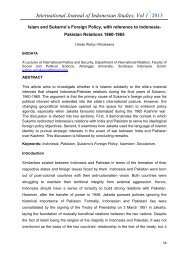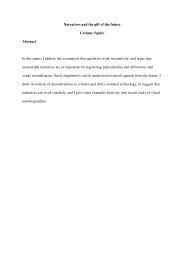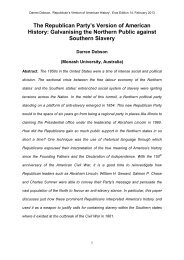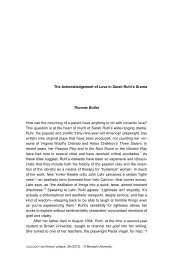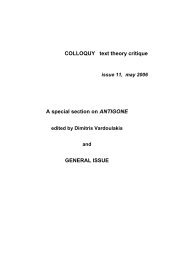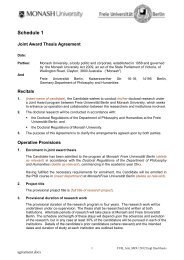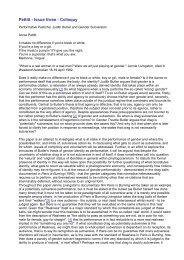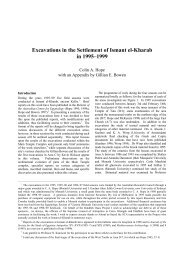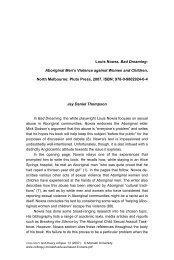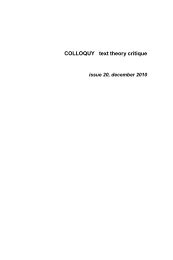Writing the Subject: Virginia Woolf - Arts - Monash University
Writing the Subject: Virginia Woolf - Arts - Monash University
Writing the Subject: Virginia Woolf - Arts - Monash University
Create successful ePaper yourself
Turn your PDF publications into a flip-book with our unique Google optimized e-Paper software.
<strong>Writing</strong> <strong>the</strong> <strong>Subject</strong>:<strong>Virginia</strong> <strong>Woolf</strong> and Clo<strong>the</strong>sCarolyn Abbs<strong>Virginia</strong> <strong>Woolf</strong> had a fascination with clo<strong>the</strong>s and textiles. She wroteabout clo<strong>the</strong>s in her diaries, fiction and non-fiction and she even wrote forVogue magazine – <strong>the</strong> editor was a friend. 1 There may have been some influencefrom William Morris’s designs and tapestries, <strong>the</strong> Omega workshopsof <strong>the</strong> time, Serge Diaghilev and costume designs for <strong>the</strong> BalletsRusses, and we know that she worked needlepoint with her sister VanessaBell. However, in regard to writing <strong>the</strong> subject, it was more than a merefascination with clo<strong>the</strong>s: she recognized <strong>the</strong> important link between clo<strong>the</strong>sand <strong>the</strong> body. The o<strong>the</strong>r aspect of her life and work of relevance here is herintrigue with childhood and childhood experience – particularly <strong>the</strong> memoryof her mo<strong>the</strong>r. I am interested in <strong>the</strong> way <strong>Woolf</strong>’s fascination with clo<strong>the</strong>sand intrigue are entwined with childhood experience and memory in herwork. In this paper, I suggest that <strong>Virginia</strong> <strong>Woolf</strong> has a method of writing<strong>the</strong> subject that involves clo<strong>the</strong>s and textiles. The method stems from herautobiographical writing, in particular <strong>the</strong> childhood memory of her mo<strong>the</strong>r,and is carried through into her novelistic practice. I will argue that <strong>Woolf</strong> isable to fictionalize/ re-work memory as perception of <strong>the</strong> body by involving“clo<strong>the</strong>s and textiles”; 2 that is, she understands a confluence between bodyand clo<strong>the</strong>s which she writes via <strong>the</strong> nonverbal and, in particular, <strong>the</strong> tactileto create <strong>the</strong> subject in her writing practice. It is this confluence which I un-COLLOQUY text <strong>the</strong>ory critique 11 (2006). © <strong>Monash</strong> <strong>University</strong>.www.arts.monash.edu.au/o<strong>the</strong>rs/colloquy/issue11/abbs.pdf
210Carolyn Abbs░derstand as “writing <strong>the</strong> subject.”The “confluence” of body and clo<strong>the</strong>s can be defined as Flugel does inThe Psychology of Clo<strong>the</strong>s. Clo<strong>the</strong>s create a variety of illusions such as todo with status, power, size, space and so on, according to Flugel, but <strong>the</strong>very fundamental importance of clo<strong>the</strong>s is <strong>the</strong> illusion of <strong>the</strong> identity betweenbody and clo<strong>the</strong>s. This however is no more than an effect known toAnd,psychologists as “confluence.” In this illusion, <strong>the</strong> mind fails to distinguishtwo things which under o<strong>the</strong>r circumstances are easily keptapart. … The extension of <strong>the</strong> total (human) figure, really due toclo<strong>the</strong>s, is unconsciously attributed to <strong>the</strong> body that wears <strong>the</strong>m, asbeing <strong>the</strong> more vital and interesting portion of <strong>the</strong> whole. 3Apart from face and hands – which, it is true, are <strong>the</strong> most sociallyexpressive parts of our anatomy, and to which we have learnt to devotean especially alert attention – what we actually see and react toare, not <strong>the</strong> bodies, but <strong>the</strong> clo<strong>the</strong>s of those about us. 4This paper will commence with an analysis of certain detail in <strong>Woolf</strong>’s autobiographicalwork “A Sketch of <strong>the</strong> Past” and <strong>the</strong>n define what I see as herextension of Bergson’s <strong>the</strong>ory of memory. This will <strong>the</strong>n enable me to discussher method of writing <strong>the</strong> subject as a political ficto-performative subjectin her novelistic practice.Autobiographical <strong>Writing</strong>sAs mentioned above, <strong>Woolf</strong>’s ability to fictionalize memory as perceptionseems to be developed from, and to begin with, a conceptual understandingof <strong>the</strong> memory of her mo<strong>the</strong>r. The following analysis of three briefmoments from <strong>Woolf</strong>’s autobiographical work “A Sketch of <strong>the</strong> Past” shouldhelp us to begin to understand this concept.I begin: <strong>the</strong> first memory. This was of red and purple flowers on ablack background − my mo<strong>the</strong>r’s dress; and she was ei<strong>the</strong>r in a trainor in an omnibus, and I was on her lap. I <strong>the</strong>refore saw <strong>the</strong> flowersshe was wearing very close; and can still see purple and red andblue, I think, against <strong>the</strong> black; <strong>the</strong>y must have been anemones, Isuppose. 5Certainly <strong>the</strong>re she was, in <strong>the</strong> very centre of that great Ca<strong>the</strong>dralspace which was childhood; <strong>the</strong>re she was from <strong>the</strong> very first. Myfirst memory is of her lap; <strong>the</strong> scratch of some beads on her dress
░ <strong>Writing</strong> <strong>the</strong> <strong>Subject</strong> 211comes back to me as I pressed my cheek against it. Then I see herin her white dressing gown on <strong>the</strong> balcony; and <strong>the</strong> passion flowerwith <strong>the</strong> purple star on its petals. Her voice is still faintly in my ears −decided quick; and in particular <strong>the</strong> little drops with which laughended – three diminishing ahs … ‘Ah-ah-ah …’ I sometimes end alaugh that way myself. And I see her hands, like Adrian’s, with <strong>the</strong>very individual square-tipped finger, each finger with a waist to it,and <strong>the</strong> nail broadening out. (My own are <strong>the</strong> same size all <strong>the</strong> way,so that I can slip a ring over my thumb.) She had three rings; a diamondring, an emerald ring, and an opal ring. … 6Also I hear <strong>the</strong> tinkle of her bracelets, made of twisted silver... I donot think that I separated her face from that general being; or fromher whole body. 7I want to argue that <strong>the</strong> clo<strong>the</strong>s and, in particular, <strong>the</strong> fabric of her mo<strong>the</strong>r’sclo<strong>the</strong>s in <strong>the</strong>se quotations, play a role in conveying <strong>the</strong> childhood memory.It is important to note <strong>the</strong> emphasis upon <strong>the</strong> fact that it is “<strong>the</strong> first memory,”for <strong>Woolf</strong> was forever striving to achieve that first memory as far backas possible before adulthood and experience of life diluted and inhibitedher feelings. In <strong>the</strong> first quote it is <strong>the</strong> memory of proximity with her mo<strong>the</strong>r;she is “sitting on her lap.” What is interesting about this piece is <strong>the</strong> way itplays with <strong>the</strong> visual in <strong>the</strong> cinematic sense, initially, to exhibit visual closeness.The filmic type of close-up of <strong>the</strong> flowers on <strong>the</strong> dress sets up a myopicfocus so that <strong>the</strong>re is a nearness that is both emotional and physical.The colours on <strong>the</strong> dress produce a certain painterly effect and rhythm of<strong>the</strong> body – “red and purple.” Next, <strong>the</strong> blackness of <strong>the</strong> background of <strong>the</strong>flowers on <strong>the</strong> dress provides a void so that <strong>the</strong>re is <strong>the</strong> feeling of beingalone with <strong>the</strong> flowers, that is, immersed in <strong>the</strong> rhythm and separate from<strong>the</strong> rest of <strong>the</strong> world. The mo<strong>the</strong>r is her world. These flowers <strong>the</strong>n procure avirtual life in <strong>the</strong> present when in retrospect <strong>the</strong> child subject proposes that<strong>the</strong>se flowers must have been anemones. They become real flowers sothat <strong>the</strong> olfactory comes into play; we smell <strong>the</strong> perfume of <strong>the</strong> flowers becausewe are as if so near. In consequence, <strong>the</strong> perfume of <strong>the</strong> flowers is<strong>the</strong>n super-imposed upon <strong>the</strong> mo<strong>the</strong>r and becomes as if <strong>the</strong> mo<strong>the</strong>r's perfume.And as part of <strong>the</strong> dress, <strong>the</strong> perfume and flowers cause <strong>the</strong> dress(to which she is close) to be <strong>the</strong> mo<strong>the</strong>r. That is, <strong>the</strong>re is a confluence betweenher body and dress. The activation of <strong>the</strong> proximal sense betweenmo<strong>the</strong>r and child is juxtaposed against <strong>the</strong> indefinite sense of place: “shewas ei<strong>the</strong>r in a train or in an omnibus,” so that emphasis is of being on herlap. Even <strong>the</strong> fact of <strong>the</strong> anemones is not absolutely clear if we take intoaccount <strong>the</strong> concluding adjunct of “I suppose.” The indefiniteness of de-
212Carolyn Abbs░scription could be regarded as a painterly blurring type of Post-Impressionistic effect, but it should not be left at <strong>the</strong> aes<strong>the</strong>tic level of interpretation.Part of <strong>the</strong> reason is that <strong>the</strong> inexactness of vision produces acorporeality of indefiniteness that, for <strong>Woolf</strong>, provided <strong>the</strong> impetus for <strong>the</strong>production of ficto-performative subjects, as will be shown in due course.The second quotation is once again about “first memory” and mediatedin terms of <strong>the</strong> aes<strong>the</strong>tics of <strong>the</strong> fragmented dream space, or cinematicmontage, while maintaining an emphasis on proximity betweenmo<strong>the</strong>r and child, both near and far. The montage shifts between close-upand long shots putting emphasis, once again, upon <strong>the</strong> proximity that isboth emotional as well as physical. Even <strong>the</strong> long shot of <strong>the</strong> dressinggownimplies an intimate knowledge of <strong>the</strong> tactile feeling of <strong>the</strong> cloth due to<strong>the</strong> understanding produced in <strong>the</strong> following close-up. While <strong>the</strong> mo<strong>the</strong>r isdescribed as “<strong>the</strong> centre of that great Ca<strong>the</strong>dral space of childhood,” as ifboth physically as well as spiritually towering over <strong>the</strong> child, it is not <strong>the</strong>verbal that directly confirms presence. Ra<strong>the</strong>r, it is <strong>the</strong> visual image of <strong>the</strong>Madonna and child (created through <strong>the</strong> verbal) that conveys emotion, anda certain awesome spirituality out of a visual painterly aspect. However, Iargue that it is <strong>the</strong> cloth of <strong>the</strong> dressing-gown that summons <strong>the</strong> child tobecome enfolded so <strong>the</strong>re is a fluid type of merging, between child, mo<strong>the</strong>rand cloth.Next, it is <strong>the</strong> beads on <strong>the</strong> dress that not only cause <strong>the</strong> felt, tactile,presence of <strong>the</strong> mo<strong>the</strong>r but simultaneously dispel <strong>the</strong> spiritual myth. As displeasure,<strong>the</strong> scratch of <strong>the</strong> beads is as if a reprimand from <strong>the</strong> mo<strong>the</strong>r –“<strong>the</strong> scratch of some beads on her dress comes back to me as I pressedmy cheek against it.” The mo<strong>the</strong>r is now a human mo<strong>the</strong>r as opposed to amythical figure in that she is denied spiritual “perfection.” Instead, she reprimands<strong>the</strong> child, causing pain, which contritely, reinforces <strong>the</strong> recollectedcloseness. Similarly, while <strong>the</strong> vision of <strong>the</strong> mo<strong>the</strong>r “in her white dressinggownon <strong>the</strong> balcony” depicts a certain e<strong>the</strong>real presence, it is <strong>the</strong> followingclose-up of “<strong>the</strong> passion flower with <strong>the</strong> purple star on its petals” that refocuses<strong>the</strong> mo<strong>the</strong>r as bodily rhythm. Her presence is confirmed by <strong>the</strong> recalledlaughter which is <strong>the</strong>n superimposed upon a self as if it is her laughternow or at least an inherited laughter. The comparison of <strong>the</strong> hands ispertinent, that is, between Adrian, <strong>the</strong> mo<strong>the</strong>r and <strong>the</strong> self, But it should bestressed that it is <strong>the</strong> jewellery that not only enables presence but, far moreimportantly, it enables <strong>the</strong> “o<strong>the</strong>r’s” hand to feel like her own. There is amerging of selves, a linking caused by <strong>the</strong> rings that once again produce<strong>the</strong> feeling of putting on <strong>the</strong> rings while recalling <strong>the</strong> o<strong>the</strong>r hands. “And I seeher hands, like Adrian’s, with <strong>the</strong> very individual square-tipped finger, eachfinger with a waist to it, and <strong>the</strong> nail broadening out. (My own are <strong>the</strong> same
░ <strong>Writing</strong> <strong>the</strong> <strong>Subject</strong> 213size all <strong>the</strong> way, so that I can slip a ring over my thumb.) She had threerings; a diamond ring, an emerald ring, and an opal ring.”In <strong>the</strong> third quote, <strong>the</strong> tinkling sound of her mo<strong>the</strong>r’s bracelets is verymuch her sound as was her laughter. She has a general being that is amerging of bracelets, face and whole body. Yet it is <strong>the</strong> fact that <strong>the</strong>y aremade of twisted silver that gives <strong>the</strong> impression of <strong>the</strong> child twisting <strong>the</strong>bracelets on <strong>the</strong> mo<strong>the</strong>r’s arm; or her own arm. It is a strong tactile and performativeimage.Also I hear <strong>the</strong> tinkle of her bracelets, made of twisted silver... I donot think that I separated her face from that general being; or fromher whole body. 8There is a persistent activation of multiple senses – visual, auditory, olfactory,tactile – in <strong>Woolf</strong>’s autobiographical work and I am interested in howshe reworks this method in her fiction. I shall argue, as stated earlier, that<strong>Woolf</strong> creates <strong>the</strong> subject via clo<strong>the</strong>s and textiles due to her understandingof <strong>the</strong> confluence of clo<strong>the</strong>s and <strong>the</strong> body; and that she includes her ownexperiential ficto-autobiographical memory. In o<strong>the</strong>r words, I maintain that<strong>Woolf</strong> fictionalizes memory as perception and, in particular <strong>the</strong> intenselyemotional memory of her mo<strong>the</strong>r in order to create <strong>the</strong> subject. It will beproductive now to define some understanding of <strong>Woolf</strong>’s philosophy ofmemory.Memory: Beyond BergsonWith regard to memory, <strong>Woolf</strong> is most often read as a Bergsonian orfollower of Proust. While she did perhaps work with some ideas that weresimilar to that of Bergson’s, it is a mistake to regard her merely as a Bergsonian.9 The main difference is that she worked with recollected memory in<strong>the</strong> manner of childhood feelings and sensations and it is in this respectthat she is considered to be Proustian. However, it seems that <strong>Woolf</strong> extends<strong>the</strong> aims of Proust to include <strong>the</strong> political. While Proust is famous forrecalling <strong>the</strong> sensation of childhood, such as in <strong>the</strong> well-known petite madeleineepisode, 10 <strong>Woolf</strong> recovers childhood feelings and fictionalizes (reworks)<strong>the</strong>m so as to mediate certain sensations that create <strong>the</strong> subject asa politics of <strong>the</strong> body in writing. Her achievements in this regard are complexand partly to do with an understanding of writing itself but also with <strong>the</strong>way she comprehends memory; and in many ways an extension of Bergson’sideas on memory as well as Proustian memory. Let us begin with <strong>the</strong>thoughts of Bergson that are relevant.Bergson proposes that <strong>the</strong>re are three aspects of memory: pure mem-
214Carolyn Abbs░ory, memory-image, and perception. He posits that pure memory andmemory-images are realized from <strong>the</strong> Perception of <strong>the</strong> present.Whenever we are trying to recover a recollection, to call up someperiod of our history, we become conscious of an act sui generis bywhich we detach ourselves from <strong>the</strong> present in order to replace ourselves,first in <strong>the</strong> past in general, <strong>the</strong>n in a certain region of <strong>the</strong> past– a work of adjustment, something like <strong>the</strong> focussing of a camera.But our recollection still remains virtual; we simply prepare ourselvesto receive it by adopting <strong>the</strong> appropriate attitude. Little by little itcomes into view like a condensing cloud; from <strong>the</strong> virtual state itpasses into <strong>the</strong> actual; and as its outlines become more distinct andits surface takes on colour, it tends to imitate perception. But it remainsattached to <strong>the</strong> past by its deepest roots. 11<strong>Virginia</strong> <strong>Woolf</strong> had a keen interest in cinema 12 and we can see that sheworks with traits of <strong>the</strong> cinema in her writing such as, for instance, closeupsenable things to “come into view” and imitate perception. Yet, it is in<strong>the</strong> previous sentence, where Bergson says that we “prepare ourselves tosee it by appropriating <strong>the</strong> right attitude,” that we begin to see how <strong>Woolf</strong>differs. It seems <strong>the</strong>re are two main differences between <strong>Woolf</strong> and Bergson.The first is that <strong>the</strong> adopted appropriate attitude, for <strong>Woolf</strong>, is specificand one of childhood feelings and sensations. So far we have only seenthis childhood attitude in relation to <strong>the</strong> memory of her mo<strong>the</strong>r. I now wantto work towards arguing that in her fictional writing, that is, in <strong>the</strong> presentationof subjects, she also applies a similar attitude of childhood in order tocreate <strong>the</strong> uninhibited closeness which children so often live in relation too<strong>the</strong>rs. The second difference is related to <strong>the</strong> first in that <strong>Woolf</strong> does indeedappropriate <strong>the</strong> Proustian attitude of <strong>the</strong> recollection of a broad rangeof childhood sensations, whereas Bergson seems to want to put <strong>the</strong> mainemphasis upon <strong>the</strong> visual. For instance, Bergson stresses <strong>the</strong> visual focussingin <strong>the</strong> latter part of <strong>the</strong> above quote. “Little by little it comes into viewlike a condensing cloud; from <strong>the</strong> virtual state it passes into <strong>the</strong> actual; andas its outlines become more distinct and its surface takes on colour, ittends to imitate perception.” (<strong>Woolf</strong> does not rely merely on <strong>the</strong> visual butworks with multiple senses.) This is in fact partly <strong>the</strong> reason that Bergson<strong>the</strong>n argues for <strong>the</strong> impossibility of pure memory because we are inclinedto adopt a memory-image that in effect denies or obliterates pure memorybecause of perception.If it is <strong>the</strong> remembered image that we are considering, we are biddento take it already made, realized in a weak perception, and to shutour eyes to <strong>the</strong> pure memory which this image has progressively de-
░ <strong>Writing</strong> <strong>the</strong> <strong>Subject</strong> 215veloped. In <strong>the</strong> rivalry which associationism thus sets up between<strong>the</strong> stable and <strong>the</strong> unstable, perception is bound to expel <strong>the</strong> memory-image,and <strong>the</strong> memory-image to expel pure memory. And thus<strong>the</strong> pure memory disappears altoge<strong>the</strong>r. 13A memory-image does indeed expel pure memory because it obliterates, orat least works instead of pure memory, as in representation, and thus causinga barrier between <strong>the</strong> past and present. Bergson states that “To pictureis not to remember.” 14 And memory-image type of writing was, of course,part of <strong>the</strong> aes<strong>the</strong>tics of realism. As a modernist, <strong>Woolf</strong> aims ra<strong>the</strong>r, to present<strong>the</strong> subject as one who feels and, although she does produce images,<strong>the</strong>y are not reliant on <strong>the</strong> visual as in direct delineation and nor are <strong>the</strong>yreliant on <strong>the</strong> verbal, albeit through <strong>the</strong> verbal. Thus <strong>the</strong> type of perceptionnow differs. Bergson argues that we cannot know <strong>the</strong> past unless we putourselves in it (which, of course, we cannot do in any literal sense) but, aswe have seen, <strong>Woolf</strong> manages to re-create <strong>the</strong> feeling of being in <strong>the</strong> past.Yet, with regard to writing <strong>the</strong> body as movement, <strong>Woolf</strong> does followBergson, to a certain extent, in <strong>the</strong> way he understands <strong>the</strong> present and indeedpast to be a determination of a future.[W]hat I call “my present” has one foot in my past and ano<strong>the</strong>r in myfuture … next, because this moment is impending over <strong>the</strong> future: itis to <strong>the</strong> future that I am tending. … The psychical state, <strong>the</strong>n, that Icall my “present,” must be both a perception of <strong>the</strong> immediate pastand a determination of <strong>the</strong> immediate future … my present consistsin a joint system of sensations and movements. … my present consistsin <strong>the</strong> consciousness that I have of my body. 15<strong>Woolf</strong>’s difference, however, is fundamental because Bergson can only understand<strong>the</strong> body in <strong>the</strong> present. He does not realize that <strong>the</strong> body of <strong>the</strong>past can live by ano<strong>the</strong>r means such as in writing.My actual sensations occupy definite portions of <strong>the</strong> surface of mybody; pure memory, on <strong>the</strong> o<strong>the</strong>r hand, interests no part of my body.No doubt, it will beget sensations as it materializes; but at that verymoment it will cease to be a memory and pass into <strong>the</strong> state of apresent thing, something actually lived. 16Bergson fails to realize that in pure memory <strong>the</strong> body cannot play a role.The problem, or at least his difference, is that Bergson, unlike <strong>Woolf</strong>, isnot referring to a specific type of language with <strong>the</strong> use of multiple sensesto convey memory. <strong>Woolf</strong> does not tell all in terms of language but, ra<strong>the</strong>r,part of her strategy is to activate multiple senses – such as <strong>the</strong> visual, haptic,auditory and so on – via and through language to <strong>the</strong> extent that <strong>the</strong>
216Carolyn Abbs░nonverbal dominates. Not only does she create a corporeal presence of hermo<strong>the</strong>r in her autobiographical writing (as demonstrated above) but, shealso carries this through to her novelistic practice in that she fictionalizesmemory as perception via <strong>the</strong> nonverbal and at times <strong>the</strong> non-visual. Thistype of writing differs because, by focussing on multiple senses, <strong>the</strong> languageoperates with what might be described as a certain “literary aphasia”17 in that it feels, it touches, it hears and so on, and develops an alterity18 of <strong>the</strong> subject. It is by no means an objective representation but instead,a very private and secret memory that cannot be created in ordinaryeveryday language. By working with <strong>the</strong> nonverbal she is able to achieveher aim of writing <strong>the</strong> body. While it is construed from <strong>the</strong> fictionalization ofmemory in perception, it is through <strong>the</strong> inclusion of <strong>the</strong> aes<strong>the</strong>tic dimensionsof clo<strong>the</strong>s and textiles that she writes <strong>the</strong> political. I want to arguenow that for <strong>Woolf</strong> <strong>the</strong>re is a domination of <strong>the</strong> tactile. In this regard, let usnow look a little more at <strong>the</strong> importance of <strong>the</strong> tactile in memory in order tounderstand how memory becomes fictionalized/re-written as perceptionand produces <strong>the</strong> body.Memory: The TactileMy point now is that <strong>the</strong> tactile is very much to do with memory. Earlierin <strong>the</strong> paper, we discussed some of <strong>Woolf</strong>’s autobiographical writing. I nowwant to take a step fur<strong>the</strong>r and define how she transforms her ability towrite about <strong>the</strong> “closeness” of her mo<strong>the</strong>r into <strong>the</strong> creation of a selfhoodand indeed o<strong>the</strong>r subjects. It is to do with her ability to fictionalize memoryas perception, but <strong>the</strong> transformation has specificities of <strong>the</strong> tactile as wellas complexities that will need unpacking. In terms of <strong>the</strong> subject and bodilycloseness, <strong>Woolf</strong> works with <strong>the</strong> nonverbal with a specific emphasis upon<strong>the</strong> tactile. As Horst Ruthrof has argued in The Body in Language, when wego beyond ordinary syntax “we step into <strong>the</strong> sign systems of <strong>the</strong> body.” 19That is, when we work with o<strong>the</strong>r senses beyond <strong>the</strong> verbal and understandby a form of “perceptual or quasi-perceptual” fantasy which is inherentlytactile, olfactory and so on: <strong>the</strong> corporeal signified is <strong>the</strong> “linguistic signifieractivated by nonverbal signs.” 20 <strong>Woolf</strong> is profoundly aware of <strong>the</strong> rememberednon-linguistic sensations of childhood.I am hardly aware of myself, but only of sensation. I am only <strong>the</strong>container of <strong>the</strong> feeling of ecstasy, of <strong>the</strong> feeling of rapture. Perhapsthis is characteristic of all childhood memories; perhaps it accountsfor <strong>the</strong>ir strength. Later we add to feelings much that makes <strong>the</strong>mmore complex; and <strong>the</strong>refore less strong; or if not less strong lessisolated, less complete. 21
░ <strong>Writing</strong> <strong>the</strong> <strong>Subject</strong> 217This is a very personal perspective on memory with a profundity of sensationand feeling. In a memory of St Ives, we can note, in particular, how<strong>Woolf</strong> stresses that it is not possible to describe (in language) <strong>the</strong> “rapture”and yet <strong>the</strong> sense of “rapture” is excessive.The next memory − all <strong>the</strong>se colour-and-sound memories hang toge<strong>the</strong>rat St Ives – was much more robust; it was highly sensual. Itwas later. It still makes me feel warm; as if everything were ripe;humming; sunny; smelling so many smells at once; and all making awhole that even now makes me stop – as I stopped <strong>the</strong>n going downto <strong>the</strong> beach; I stopped at <strong>the</strong> top to look down at <strong>the</strong> gardens. Theywere sunk beneath <strong>the</strong> road. The apples were on a level with one’shead. The gardens gave off a murmur of bees; <strong>the</strong> apples were redand gold; <strong>the</strong>re were also pink flowers; and grey and silver leaves.The buzz, <strong>the</strong> croon, <strong>the</strong> smell, all seemed to press voluptuouslyagainst some membrane; not to burst it; but to hum round one sucha complete rapture of pleasure that I stopped, smelt; looked. Butagain I cannot describe <strong>the</strong> rapture. It was rapture ra<strong>the</strong>r than ecstasy.22There is <strong>the</strong> emphasis on “colour and sound memories” that hang toge<strong>the</strong>r,but what does this emphasis do but activate o<strong>the</strong>r senses such as <strong>the</strong> haptic,olfactory, proximal and tactile so that we understand that none operateon <strong>the</strong>ir own nor rely on <strong>the</strong> verbal for meaning. However, it is this lateralmeans of making meaning via a multitude of senses that accrues <strong>the</strong> dominanceof <strong>the</strong> tactile and in turn seems to be <strong>the</strong> understanding of rapture.Notice how she stops to touch, as if it is to stop time, to form a repetition, aperpetuation, to install <strong>the</strong> feeling of rapture as tactile.Next, I want to look at a couple of <strong>Woolf</strong>’s childhood memories of oldwomen because I think that <strong>the</strong>y exemplify how <strong>Woolf</strong> begins to develop<strong>the</strong> tactile sense of <strong>the</strong> subject. These are instances, where we can recognizea potential for <strong>the</strong> transition from memory per se towards <strong>the</strong> fictionalizationor (re)writing memory as perception. The recollection of <strong>the</strong> first oldwoman is interesting for <strong>the</strong> way <strong>the</strong> writing works specifically with <strong>the</strong> nonverbaland texture in relation to clo<strong>the</strong>s and <strong>the</strong> body.The Queen’s Gate old woman was an elongated emaciated figurewith a goat-like face, yellow and pockmarked. She sold nuts andboot-laces, I think … She always sat, and wore a shawl and had tome a faint, obliterated, debased likeness to Granny; whose face waselongated too, but she wore a very soft shawl, like tapioca pudding,over her head, and it was fastened by an amethyst brooch set inpearls. 23
218Carolyn Abbs░Understanding is in terms of texture here and causes <strong>the</strong> tactile to dominate.The “goat-like face” of <strong>the</strong> old woman that is “yellow and pockmarked”gives <strong>the</strong> impression that her face is almost furry and nobbled likea goat. The amethyst brooch is proximally very close with its detail of <strong>the</strong>pearls. But it is not so much that <strong>the</strong> brooch is seen as a cinematic close-up(although this does play a minor role) but, ra<strong>the</strong>r, it is <strong>the</strong> texture of <strong>the</strong>brooch with its smoothness of <strong>the</strong> pearls that becomes super-imposedupon <strong>the</strong> old woman’s face. There is, thus, a sense of childhood’s uninhibitedrapture, as if she touches <strong>the</strong> face in awe and dispels <strong>the</strong> vision of whatmight be, from an adult’s point of view, an o<strong>the</strong>rwise ra<strong>the</strong>r unattractivepockmarked face. The face <strong>the</strong>n has an exquisite jewel-like texture. Next,and perhaps what is even more important, is <strong>the</strong> tactile softness of <strong>the</strong>shawl. While <strong>the</strong> reference to tapioca pudding may add <strong>the</strong> feeling ofwarmth and satiated comfort, it is <strong>the</strong> texture of softness that causes a certainyielding of response: 24 a certain humble relation between child andsubject that is taken even fur<strong>the</strong>r in <strong>the</strong> next excerpt. There is an inducedperformance of <strong>the</strong> subject by <strong>the</strong> child, who as such re-enacts <strong>the</strong> oldwoman’s spiderly gait, by <strong>the</strong> means of focusing upon <strong>the</strong> tactile sense oftextures.One more caricature comes into mind; though pity entered into thisone. I am thinking of Justine Nonon. She was immensely old. Littlehairs sprouted on her long bony chin. She was a hunchback; andwalked like a spider, feeling her way with her long dry fingers fromone chair to ano<strong>the</strong>r. Most of <strong>the</strong> time she sat in <strong>the</strong> arm-chair beside<strong>the</strong> fire. I used to sit on her knee; and her knee jogged up anddown; and she sang in hoarse cracked voice ‘Ron ron ron – et plonplon plon −’ and <strong>the</strong>n her knee gave and I was tumbled onto <strong>the</strong>floor. She was French; she had been with <strong>the</strong> Thackerays. She onlycame to us on visits. She lived by herself at Shepherd’s Bush; andused to bring Adrian a glass jar of honey. I got <strong>the</strong> notion that shewas extremely poor. 25While it can be argued that <strong>the</strong> presence of this old woman is accrued viamultiple nonverbal means such as rhythm, <strong>the</strong> auditory (in particular <strong>the</strong> intonation),<strong>the</strong> visual and so on, it is pertinent to argue that it is <strong>the</strong> tactilesense of texture that causes <strong>the</strong> intimacy. In o<strong>the</strong>r words, it is because <strong>the</strong>child-subject mimics <strong>the</strong> old woman (as a performance of <strong>the</strong> subject) that<strong>the</strong>re is an inference of <strong>the</strong> chair as tactile. Note how she felt her way “withher long dry fingers from one chair to ano<strong>the</strong>r.” Not only is it <strong>the</strong> texture ofher skin but <strong>the</strong> texture of <strong>the</strong> cloth on <strong>the</strong> backs of <strong>the</strong> chairs that creates<strong>the</strong> child-like fun of enacting <strong>the</strong> spiderly gait. It is to do with <strong>the</strong> understood
░ <strong>Writing</strong> <strong>the</strong> <strong>Subject</strong> 219bodily connection between subject and cloth that is <strong>the</strong> tactile response.However, I suggest that not only does <strong>Woolf</strong> create fictional subjects frommemory per se but that she also creates <strong>the</strong> subject as a selfhood through<strong>the</strong> means of clo<strong>the</strong>s. That is, she recalls <strong>the</strong> tactile experience or memoryperception of clo<strong>the</strong>s to produce a ficto-self as subject in writing.Clo<strong>the</strong>s and <strong>the</strong> Ficto-Performative SelfHowever, <strong>Woolf</strong> was not only able to develop a highly sensitive understandingof <strong>the</strong> feeling of wearing clo<strong>the</strong>s but, also, she was well aware of<strong>the</strong> power and opportunities, or <strong>the</strong> potential detriment and shame, thatclo<strong>the</strong>s could give an individual. While o<strong>the</strong>rs have discussed this diverseinterest as a double consciousness, 26 I am interested in, and will focus on,<strong>the</strong> means in which <strong>Woolf</strong> produces <strong>the</strong> subject as a self via clo<strong>the</strong>s. Thus,I am taking <strong>the</strong> idea of corporeality of <strong>the</strong> subject a step fur<strong>the</strong>r to see how<strong>Woolf</strong> presents <strong>the</strong> self as a body consciousness. She sought to research<strong>the</strong> matter fur<strong>the</strong>r and in a diary entry dated Thursday 14 th May 1925 wrote:But I must remember to write about my clo<strong>the</strong>s next time I have animpulse to write. My love of clo<strong>the</strong>s interests me profoundly; only it isnot love; & what it is I must discover. 27At times, she presents <strong>the</strong> subject by <strong>the</strong> way a subject feels wearing certaintypes of clo<strong>the</strong>s so <strong>the</strong>re is a corporeal feeling of being a subject as aself. Such a concept can be extended to say that <strong>the</strong> subject as a self iscreated by a performance, a consciousness, which is enhanced by clo<strong>the</strong>sand textiles. In a diary entry dated Monday 27 th April, 1925 we can observeher interest in different levels of consciousness.But my present reflection is that people have any number of statesof consciousness: &c. I should like to investigate <strong>the</strong> party consciousness,<strong>the</strong> frock consciousness &c. 28Yet, she still works with memory. As opposed to being <strong>the</strong> memory of hermo<strong>the</strong>r recalled so as to produce a bodily closeness of an o<strong>the</strong>r subject, wenow work towards understanding her means of creating a self as subject inwriting. This is an intimate knowledge of a selfhood and thus a greatercloseness than we have seen so far. Because we are dealing with feelingsthat we might consider to be of <strong>the</strong> specific, as well as non-specific, it isworthwhile running through some of <strong>the</strong> layers of consciousness to do with<strong>the</strong> wearing of clo<strong>the</strong>s. Again, I shall first return to a “Sketch of <strong>the</strong> Past”where <strong>Woolf</strong> speaks of <strong>the</strong> shame that can be related to <strong>the</strong> wearing of certainclo<strong>the</strong>s.
220Carolyn Abbs░Vanessa and I were both what was called tomboys. … Perhaps<strong>the</strong>refore to have been found looking in <strong>the</strong> glass would have beenagainst our tomboy code. But I think that my feeling of shame went agreat deal deeper. … Everything to do with dress – to be fitted, tocome into a room wearing a new dress – still frightens me; at leastmakes me shy, self-conscious uncomfortable. …Yet femininity wasvery strong in our family. We were famous for our beauty – mymo<strong>the</strong>r’s beauty, Stella’s beauty, gave me as early as I can remember,pride and pleasure. What <strong>the</strong>n gave me this feeling of shame,unless it were that I inherited some opposite instinct? My fa<strong>the</strong>r wasspartan. 29The shame here is like a torment imposed upon <strong>the</strong> body and exemplifies<strong>the</strong> confluence between body and clo<strong>the</strong>s in that, as is stated, shame is“everything to do with dress – to be fitted, to come into a room wearing anew dress” and so on. But what is of particular interest here is <strong>the</strong> way itgives <strong>the</strong> memory of <strong>the</strong> intimate feelings of <strong>the</strong> shame of <strong>the</strong> body. Thisshame has perhaps a causal history to do with <strong>the</strong> sexual abuse <strong>Woolf</strong> receivedas a child and more general “bourgeois Victorian taboos surrounding<strong>the</strong> body.” 30 But we can also observe that she put such experience towork in her philosophy of <strong>the</strong> subject – as a fictionalization/re-working ofmemory as perception. The feelings of <strong>the</strong> subject are expressed in a nonverbalmanner (and indeed via clo<strong>the</strong>s) in that <strong>the</strong> fear and shame is describedin terms of <strong>the</strong> tactile: to be fitted; to be touched. In addition <strong>the</strong>subject is not <strong>the</strong> one that looks but ra<strong>the</strong>r, <strong>the</strong> feeling of being observed isportrayed by movement of <strong>the</strong> body: “to come into a room” as if with loweredeyes. This excerpt from “A Sketch” can almost be regarded as a prototypeof <strong>the</strong> short story “The New Dress” although as we shall see <strong>the</strong>nonverbal, <strong>the</strong>oretical aspect is extended. We have in this story <strong>the</strong> senseof a performance of what Hermione Lee has called a “secret self.” 31 Thereis a sense of being <strong>the</strong> subject that differs from being near o<strong>the</strong>r subjectssuch as was described in relation to <strong>Woolf</strong>’s mo<strong>the</strong>r because <strong>the</strong>re is accessto her thoughts.[O]h <strong>the</strong>se men, oh <strong>the</strong>se women were thinking – “What’s Mabelwearing? What a fright she looks! What a hideous new dress!”… But she dared not look in <strong>the</strong> glass. She could not face <strong>the</strong>whole horror − <strong>the</strong> pale yellow, idiotically old-fashioned silk dresswith its long skirt and its high sleeves and its waist and all <strong>the</strong> thingsthat looked so charming in <strong>the</strong> fashion book, but not on her, notamong all <strong>the</strong>se ordinary people. She felt like a dressmaker’sdummy standing <strong>the</strong>re, for young people to stick pins into. 32
░ <strong>Writing</strong> <strong>the</strong> <strong>Subject</strong> 221It is not so much how she feels, but ra<strong>the</strong>r that her feelings are portrayedby nonverbal emotions and sensations. The visual delineation is limited inthat she does not look (in <strong>the</strong> glass) nor is <strong>the</strong> fact that she is being lookedat defined in a verbal manner. Instead, it is <strong>the</strong> tactile that produces <strong>the</strong>feeling of a self and once again it is <strong>the</strong> bodily aspect of language thatgives meaning. There is <strong>the</strong> tactile feeling of wearing <strong>the</strong> silk dress, whichcould o<strong>the</strong>rwise be sensual if <strong>the</strong> sensuality was not diminished by <strong>the</strong> lackof power which is signified as above by <strong>the</strong> lowering of <strong>the</strong> eyes that merelynotices <strong>the</strong> “long skirt.” The painful situation is <strong>the</strong>n metaphorically summarisedby <strong>the</strong> pins that are stuck into her as if she were a dressmaker’sdummy. In o<strong>the</strong>r words, it is <strong>the</strong> feeling of immobility that is so disempoweringand this immobility and shame is caused by <strong>the</strong> particular dress. However,<strong>Woolf</strong> was, of course, not writing about <strong>the</strong> disempowerment ofwomen but, ra<strong>the</strong>r, <strong>the</strong> empowerment of women as subjects and this example,we might say, highlights <strong>the</strong> important link between clo<strong>the</strong>s and <strong>the</strong>body.In a manner similar to how Flugel was interested in how clo<strong>the</strong>s couldempower <strong>the</strong> body, <strong>Woolf</strong> also used clothing to enable <strong>the</strong> subject to performin an empowering manner. According to Flugel, “clothing, by adding to<strong>the</strong> apparent size of <strong>the</strong> body in one way or ano<strong>the</strong>r, gives us an increasedsense of power, a sense of extension of our bodily self – ultimately by enablingus to fill more space.” 33 Whereas in <strong>the</strong> previous example <strong>Woolf</strong>’ssubject has limited space and little or no extension of <strong>the</strong> body (as in <strong>the</strong>appropriation of fur<strong>the</strong>r bodily space with clo<strong>the</strong>s), at o<strong>the</strong>r times she mobilizes<strong>the</strong> body and extends space with <strong>the</strong> use of clo<strong>the</strong>s. Watch how notonly is space made for Ottoline in <strong>the</strong> diary entry here dated Friday 13 thFebruary, 1920 – “I must spare a phrase [space]” – but also how <strong>the</strong> colourof <strong>the</strong> dress dominates <strong>the</strong> room; it is brought close by <strong>the</strong> tactile sense of<strong>the</strong> silk. “I must spare a phrase for <strong>the</strong> sealing wax green of Ottoline’sdress. This bright silk stood out over genuine crinoline. She did control <strong>the</strong>room on account of it.” 34 This diary entry is perhaps a memory ripe for<strong>Woolf</strong> to fictionalize as perception but <strong>the</strong>re is often an overlap between<strong>Woolf</strong>’s fictional writing and non-fiction. It is as if she practiced her fiction in<strong>the</strong> diaries. The difference in <strong>the</strong> diary entry here, for instance, is that shetells us that Ottoline controlled <strong>the</strong> room on account of <strong>the</strong> dress whereas in<strong>the</strong> fictional texts <strong>the</strong> meaning is more likely to be conveyed via <strong>the</strong> nonverbalsuch as in <strong>the</strong> next excerpt from “The New Dress.”Miss Milan’s little workroom was really terribly hot, stuffy, sordid. Itsmelt of clo<strong>the</strong>s and cabbage cooking; and yet when Miss Milan put<strong>the</strong> glass in her hand, and she looked at herself with <strong>the</strong> dress on,finished, an extraordinary bliss shot through her heart. Suffused with
222Carolyn Abbs░light, she sprang into existence. 35Boredom and <strong>the</strong> unpleasantness of <strong>the</strong> situation (being fitted for clo<strong>the</strong>sas mentioned earlier as well as <strong>the</strong> smell of cabbage cooking) precede <strong>the</strong>delight of <strong>the</strong> empowered performance of <strong>the</strong> subject as she looks in <strong>the</strong>mirror when <strong>the</strong> dress is finished. However, it is <strong>the</strong> fact that she becomesmobile as well as that she extends her space that it is empowering. “[A]nextraordinary bliss shot through her heart. Suffused with light she spranginto existence.” 36 The created energy is created by <strong>the</strong> tactile feel of <strong>the</strong>dress and brings awareness and connectedness of <strong>the</strong> body. The body is<strong>the</strong> dress. The dress is movement: <strong>the</strong> mobile body is performativity due to<strong>the</strong> confluence of dress and body. <strong>Woolf</strong> works with <strong>the</strong> confluence of bodyand clo<strong>the</strong>s to fictionalize memory and experience of sensation as perception.As we have seen in <strong>the</strong> last quote from “A Sketch of <strong>the</strong> Past,” it is <strong>the</strong>memory of <strong>the</strong> feeling of lightness of body and movement that certainclo<strong>the</strong>s give, as opposed to <strong>the</strong> inflicted humiliation by o<strong>the</strong>rs. Note how in<strong>the</strong> concluding lines of <strong>the</strong> story “The New Dress” <strong>the</strong> movement and fluidswirl of cloth create <strong>the</strong> feeling of not only presence but in addition <strong>the</strong> feelingof almost being <strong>the</strong> subject who wraps herself, round and round in <strong>the</strong>cloak.“Lies, lies, lies!” she said to herself, going downstairs, and “Right in<strong>the</strong> saucer!” she said to herself as he thanked Mrs Barnet for helpingher and wrapped herself, round and round and round, in <strong>the</strong> Chinesecloak she had worn <strong>the</strong>se twenty years. 37There is <strong>the</strong> creation of selfhood, which is tactile and cocoon-like but, alsowith <strong>the</strong> sensation of a type of unfolding free movement.Thus it can be seen that <strong>Virginia</strong> <strong>Woolf</strong>’s interest in clo<strong>the</strong>s and textilesand childhood memory are entwined in her work. Not only does she understand<strong>the</strong> confluence between body and clo<strong>the</strong>s, but she is able to fictionalizememory as perception. It seems that she has developed this method ofwriting <strong>the</strong> subject from her autobiographical writings, in particular those involving<strong>the</strong> memory of her mo<strong>the</strong>r. <strong>Woolf</strong>’s understanding of memory, <strong>the</strong>n,goes beyond Bergson’s <strong>the</strong>ory to include multiple nonverbal senses,through <strong>the</strong> verbal, with an emphasis on <strong>the</strong> tactile. By implementing thismethod in her novelistic practice she is able to create <strong>the</strong> ficto-performativesubject.Curtin <strong>University</strong> of Technologyc.abbs@exchange.curtin.edu.au
░ <strong>Writing</strong> <strong>the</strong> <strong>Subject</strong> 223NOTES1 I am disrupting <strong>the</strong> notion that <strong>Woolf</strong> wrote for Vogue purely for financial reasons,suggesting that it was perhaps in addition an interest and gave impetus for andfur<strong>the</strong>red her politico-creative writing practice.2 I shall be making no clear boundaries between “clo<strong>the</strong>s and textiles” and will includejewellery in this category.3 J.C. Flugel, The Psychology of Clo<strong>the</strong>s (London: Hogarth Press, 1971), p. 36.4 Flugel, Psychology, p. 15.5 <strong>Virginia</strong> <strong>Woolf</strong>, “A Sketch of <strong>the</strong> Past”, Moments of Being (San Diego: HarcourtBrace, 1985), p. 64.6 <strong>Woolf</strong>, “A Sketch”, p. 81.7 <strong>Woolf</strong>, “A Sketch”, p. 82.8 <strong>Woolf</strong>, “A Sketch”, p. 82.9 We cannot be sure that <strong>Woolf</strong> did actually read Bergson, but this is not my concern.Ra<strong>the</strong>r, I am interested in <strong>the</strong> similarity of some of her ideas on memory.However, we do know that Proust read Bergson and that <strong>Woolf</strong> did read Proust,so <strong>the</strong> influence may have been indirect.10 See Marcel Proust, Remembrance of Things Past: 1, trans. C.K. Scott Moncrieffand Terence Kilmartin (Hammondsworth: Penguin, 1989), pp. 48-51, where <strong>the</strong>subject recalls <strong>the</strong> childhood memory of <strong>the</strong> taste of <strong>the</strong> “petites madeleines” givento him by his mo<strong>the</strong>r.11 Henri Bergson, Matter and Memory, trans. Nancy Margaret Paul and W. ScottPalmer (New York: Allen & Unwin. 1970), p. 171.12 See for instance, <strong>Virginia</strong> Wolf’s essay, “The Cinema”, The Crowded Dance ofModern Day Life (Hamondsworth: Penguin, 1993); see also my paper on <strong>Woolf</strong>and <strong>the</strong> cinema, Carolyn Abbs, “<strong>Virginia</strong> <strong>Woolf</strong> and Gilles Deleuze: Cinematic e-motion and <strong>the</strong> Mobile <strong>Subject</strong>”, Interactive Media: E-Journal of <strong>the</strong> NationalAcademy of Screen and Sound, 1 (2005), Murdoch <strong>University</strong>, date of access:28.3.05, http://wwwmcc.murdoch.edu.au/nass/nass_current_issue.htm; and, seemany instances in <strong>Woolf</strong>’s diaries.13 Bergson, Matter, p.172.14 Bergson, Matter, pp. 173-4.15 Bergson, Matter, p. 177.16 Bergson, Matter, p. 179.17 I am not using <strong>the</strong> term “literary aphasia” in any medical or clinical sense but as ameans of referring to a disruption of <strong>the</strong> linguistic. I am suggesting that, when <strong>Virginia</strong><strong>Woolf</strong> works with multiple senses in writing to create <strong>the</strong> visual, auditory,haptic and so on, she operates with a form of “literary aphasia” and disrupts <strong>the</strong>
224Carolyn Abbs░ordinary (prose) use of language so that it leans towards “poetic” language. Forfur<strong>the</strong>r explanation of this type of language see Roman Jakobson, “On <strong>the</strong> Relationbetween Visual and Auditory Signs”, Selected <strong>Writing</strong>s, vol. 2 (The Hague:Mouton, 1971), pp. 345-59; Jakobson, Fundamentals of Language (The Hague:Mouton, 1971). And, in particular, Roman Jakobson, “The Metaphoric and MetonymicPoles”, Modern Criticism and Theory: A Reader, ed. D. Lodge (London:Longman, 1989), pp. 57-61, for a discussion on clinical aphasia in children wherehe argues that <strong>the</strong> metaphoric pole links to poetic language. From this perspective,“literary aphasia” is poetic and linguistic.18 By <strong>the</strong> use of <strong>the</strong> term “alterity” here I am merely referring to <strong>the</strong> “o<strong>the</strong>rness” of <strong>the</strong>subject in that <strong>the</strong> subject’s feelings are understood as if from her point of view.19 Horst Ruthrof, The Body in Language (London: Cassell, 2000), p. 99.20 Ruthrof, The Body, p.103.21 <strong>Woolf</strong>, “A Sketch”, p. 67.22 <strong>Woolf</strong>, “A Sketch”, p. 66.23 <strong>Woolf</strong>, “A Sketch”, p. 75.24 Gail Jones writes of softness in relation to textiles, stating that <strong>the</strong> art critic MaxKosloff in an essay entitled “The Poetics of Softness” (although writing aboutsculpture) “sought to examine how engagement with yielding substance evokes aparticular field of sensibility and response. Softness, he suggests, ‘Mimes a kind ofsurrender to <strong>the</strong> natural condition that pulls bodies down.’ In <strong>the</strong> best sense, <strong>the</strong>n,<strong>the</strong> soft edges yielding, pressure, gravity, even fatigue; that is to say it correspondsin certain hypo<strong>the</strong>tical ways to haptic intuitions – to <strong>the</strong> flexible, <strong>the</strong> organic,<strong>the</strong> elastic, <strong>the</strong> impressionable, and most of all, to <strong>the</strong> depredation of time.This might suggest why works of cloth, ‘miming surrender,’ so often suggest pathosand sentimentality. The connection is a subtle one. … It also connects, albeitobliquely, tropes of mortality, artifice and <strong>the</strong> precariousness of selfhood.” SeeGail Jones, “Four Meditations on <strong>the</strong> Poetics of Cloth”, From Within: Jane WhiteleyWorks in Cloth (Fremantle, Western Australia: Art on <strong>the</strong> Move, 1999), pp. 7-8.25 <strong>Woolf</strong>, “A Sketch”, p. 74.26 See Lisa Cohen, “Frock Consciousness: <strong>Virginia</strong> <strong>Woolf</strong>, <strong>the</strong> Open Secret, and <strong>the</strong>Language of Fashion”, Fashion Theory, 3.2 (1999), pp. 149-74; and Molly Hite,“<strong>Virginia</strong> <strong>Woolf</strong>’s Two Bodies”, Genders 31 (2000), pp. 1-22.27 <strong>Woolf</strong>, The Diary of <strong>Virginia</strong> <strong>Woolf</strong>, Volume Three: 1925-1930, ed. Anne OlivierBell (San Diego Harcourt Brace, 1980), p. 21.28 <strong>Woolf</strong>, Diary, vol. 3, p. 12.29 <strong>Woolf</strong>, “A Sketch”, p. 68.30 Sidonie Smith, <strong>Subject</strong>ivity, Identity and <strong>the</strong> Body: Women’s AutobiographicalPractices in <strong>the</strong> Twentieth Century (Bloomington: Indiana UP, 1993), p. 89.31 I am referring here to <strong>the</strong> introductory <strong>the</strong>me of Hermione Lee’s edited book ofshort stories The Secret Self: A Century of Short Stories by Women (London:Phoenix Giants, 1995).32 <strong>Virginia</strong> <strong>Woolf</strong>, “The New Dress”, The Complete Shorter Fiction of <strong>Virginia</strong> <strong>Woolf</strong>,
░ <strong>Writing</strong> <strong>the</strong> <strong>Subject</strong> 225ed. Susan Dick (San Diego: Harcourt Brace, 1989), pp. 171-2.33 Flugel, Psychology, p. 34.34 <strong>Woolf</strong>, The Diary of <strong>Virginia</strong> <strong>Woolf</strong>, Volume Two: 1920-1924, ed. Anne Olivier Bell(San Diego: Harcourt Brace, 1980), pp. 19-20.35 <strong>Woolf</strong>, “New Dress”, p. 172.36 <strong>Woolf</strong>, “New Dress”, p.172.37 <strong>Woolf</strong>, “New Dress”, p. 177.



